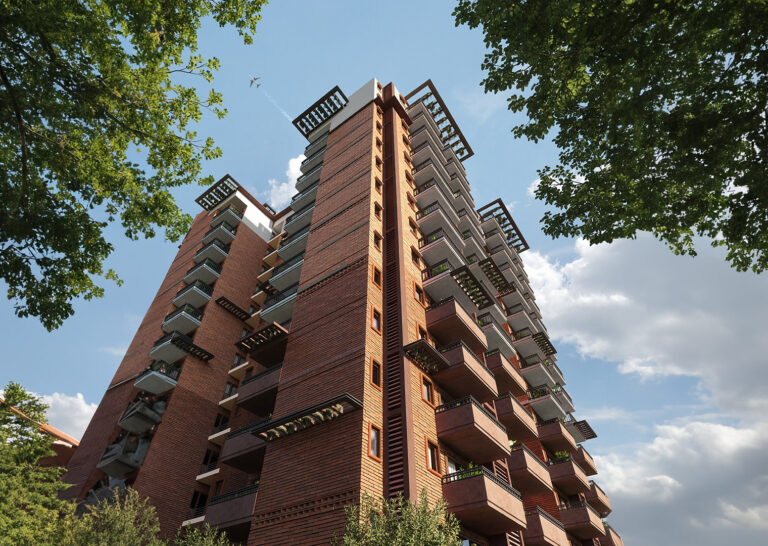Living in Harmony: The Nature-Centered Approach to Modern Homes
How often have you walked into a building and felt immediately disconnected from the world outside? The sealed windows, artificial lighting, and synthetic materials that dominate conventional construction create an unmistakable barrier between us and nature. But what if our homes could actually strengthen our connection to the natural world instead of severing it?
This question lies at the heart of Living Architecture, an approach that’s transforming how we think about our built environment. And at Melody of Life in Mohali, this philosophy comes alive in every thoughtful detail.
The Growing Disconnect: Modern Housing Challenges
Resource Depletion
The conventional construction industry has an insatiable appetite for virgin materials. Traditional building practices consume vast quantities of resources, with the cement industry alone generating approximately 8% of global carbon emissions. Each new development typically represents thousands of tons of materials extracted from the earth, often processed through energy-intensive methods and transported across long distances.
Energy Inefficiency
Walk into most modern buildings, and you’ll find environments completely dependent on mechanical systems. Poor orientation, inadequate insulation, and design that ignores local climate conditions create spaces that leak heat in winter and trap it in summer. This perpetual battle against nature results in buildings that require constant energy input just to maintain basic comfort, placing strain on both utility grids and household budgets.
Melody of life
Health Compromises
The sealed environments of conventional buildings often harbor a troubling secret: indoor air pollution. Many standard building materials release chemicals that degrade air quality—particularly concerning when we spend up to 90% of our time indoors. Add artificial lighting that disrupts circadian rhythms and minimal natural ventilation, and our homes can actively undermine our health rather than support it.
Nature Separation
Perhaps most fundamental is the psychological separation from nature that characterizes modern living. When buildings seal us away from natural light cycles, fresh air, and visual connections to the outdoors, they disrupt our bodies’ natural rhythms and deny our innate biophilic needs—the human desire to connect with nature and other forms of life.
The Living Architecture Solution
A fundamentally different approach to building design emerges when we recognize homes not as static objects but as dynamic systems that work in harmony with nature.
Climate-Responsive Design Through Rigorous Analysis
Modern architecture at its best begins with a deep understanding of the local climate. Comprehensive climatic analysis reveals how to work with nature’s patterns-
Solar movement optimization: Careful studies of the sun’s path throughout the year inform building positioning and design. By understanding exactly how solar radiation affects different sides of a structure across seasons, architects can design spaces that harness beneficial winter warmth while minimizing uncomfortable summer heat gain.
Strategic building orientation: North-facing orientation emerges from scientific analysis as optimal for the region, dramatically reducing heat absorption and creating naturally cooler indoor environments. This seemingly simple but data-driven decision significantly decreases cooling requirements throughout the year.
Protective tower placement: Tower locations aren’t arbitrary aesthetic choices but carefully calculated positions that shield residents from the harshest western and southern sun exposure—areas that receive the most intense solar radiation. This thoughtful arrangement creates a more comfortable microclimate throughout the development.
Microclimate engineering: Water bodies aren’t merely decorative features but strategically positioned elements that facilitate evaporative cooling, lowering ambient temperatures in surrounding areas. As air passes over these water features, it cools naturally before reaching residential areas—a passive cooling system based on fundamental principles of thermodynamics.
Thermal buffer creation: Analysis of heat flow informs the implementation of thermal walls and double-walled construction in areas that would otherwise experience excessive heat gain. These buffers slow the transfer of heat, keeping interiors cooler during hot days and warmer during cool nights.
Buildings That Breathe
When architecture responds intelligently to natural patterns, remarkable benefits emerge—
Ventilation pathway design: Natural airflow patterns identified through climate analysis determine window placement and room arrangements. This approach creates continuous air movement that refreshes indoor environments without mechanical systems, improving comfort while reducing energy consumption.
Daylight analysis-based architecture: Sophisticated modeling of how natural light moves through spaces throughout the day and year informs ceiling heights, window sizes, and interior layouts. The result is spaces that remain well-lit by natural light without excessive heat gain or glare.
Responsive surface treatments: Elegant trellises and lattices provide shade while supporting climbing plants that change with the seasons. These hanging plant systems not only create living building skins but also contribute to noise reduction and aesthetic appeal—architecture that evolves with the natural world rather than standing apart from it.
Climate adaptability through design: Shading devices, deep balconies, double walls, and thermal barriers work together as a sophisticated environmental regulation system. This climate responsiveness creates comfortable indoor temperatures naturally while reducing dependence on energy-intensive mechanical systems.
Biophilic Integration Inside and Out
When nature becomes an integral design partner rather than an afterthought, the benefits extend far beyond aesthetics—
Generous green coverage: Developments with over 30% dedicated green space create sanctuaries that support local biodiversity while providing daily nature connection for residents. These aren’t merely decorative landscapes but functioning ecosystems that enhance the overall living environment.
Material authenticity: The emphasis on natural, local materials brings nature’s textures, patterns, and beneficial properties indoors. Features like timeless brick elevation deliver not just beauty but practical advantages—zero maintenance facades that age gracefully rather than deteriorating, withstanding harsh weather conditions without losing their charm or requiring frequent upkeep.
Daylight abundance: Large windows, strategic orientation, and thoughtful building placement maximize natural light penetration throughout living spaces. This approach supports healthy sleep-wake cycles while dramatically reducing artificial lighting needs—a perfect example of design that benefits both human health and energy conservation.
Visual connections to nature: Thoughtfully framed views from living spaces and bedrooms keep nature ever-present in the daily experience. These visual connections satisfy our innate need for nature contact, reducing stress and enhancing wellbeing even when indoors.
Community Through Natural Design
Sustainable living extends beyond individual units to how people interact within a shared environment—
Multi-level connectivity: When towers connect through podium-level spaces, they create functional community areas that encourage natural interaction while still providing privacy when desired. This hierarchy of spaces—from private homes to semi-private podium areas to public central spaces—mirrors natural ecosystems where boundaries remain permeable yet distinct.
Age-inclusive environments: Dedicated children’s play areas with age-appropriate equipment exist alongside quiet zones for elderly residents and intellectually stimulating spaces like bookworm pavilions. This diversity of spaces ensures all residents find environments that meet their specific needs while encouraging cross-generational interaction.
Moving naturally: Two-thousand-foot-long continuous walkways create opportunities for exercise, leisure, and spontaneous neighbor encounters. By prioritizing pedestrian movement through wide, tree-lined paths and embracing universal accessibility principles, these developments make walking the most natural and pleasant way to move through the community.
Thoughtful transitions: Natural design creates intuitive flows between private, semi-private, and public spaces, encouraging interaction while respecting privacy needs. These subtle transitions mirror natural environments where borders blend rather than separate—creating communities that feel organic rather than imposed.
Materials That Honor Nature
Every material choice reflects a philosophy about our relationship with the natural world—
Reduced dependence on energy-intensive materials: By minimizing the use of products like concrete where alternatives can perform effectively, these developments dramatically lower their embodied carbon footprint while often creating healthier, more pleasant environments.
Durability as sustainability: High-quality materials that age beautifully reduce the need for frequent replacement and renovation. The timeless brick elevation that eliminates repainting requirements exemplifies this approach—a statement of craftsmanship that grows more distinguished with time rather than deteriorating.
Local sourcing priorities: Materials from nearby sources not only reduce transportation emissions but also connect buildings more authentically to their regional context. This approach strengthens local economies while creating homes with a genuine sense of place.
The Living Experience
When buildings work with nature rather than against it, residents experience the benefits in tangible, daily ways—
Natural comfort stability: The thermal properties of thoughtfully designed building envelopes—with features like double walls and deep balconies—create more stable indoor temperatures with less reliance on mechanical systems. This passive approach to comfort feels fundamentally different from the artificial environments of conventional buildings.
Seasonal attunement: Unlike static buildings that fight against natural cycles, living architecture embraces seasonal changes. Features like adjustable shading provide cooling in summer while allowing warming sunlight in winter, helping residents stay connected to natural rhythms.
Healthier indoor environments: Natural ventilation and non-toxic materials create fresher indoor air with fewer allergens and irritants. When homes breathe naturally, residents breathe easier too.
Psychological wellbeing: Abundant daylight and visual connections to green spaces support mental health by maintaining residents’ connection to weather patterns, seasonal changes, and daily cycles—subtle but powerful influences on mood and cognitive function.
A New Relationship with the Built Environment
The approach described here represents more than technical improvements—it fundamentally rethinks our relationship with the places we call home. By designing buildings as living systems rather than static objects, we create environments that—
- Heal rather than harm, both for residents and for the planet
- Work in partnership with natural systems rather than opposing them
- Provide financial benefits through reduced energy and maintenance costs
- Create greater resilience against power outages, water restrictions, and extreme weather
- Maintain and increase property value as awareness of building health impacts grows
Most importantly, this approach demonstrates that we don’t need to choose between modern comfort and environmental responsibility. As we face growing climate and resource challenges, this integrated philosophy shows us a path forward—one where our built environment supports both human wellbeing and planetary health.
The buildings we create today will shape our world for generations. By designing them as living systems that embrace slower-paced living, authenticity over excessive luxury, and genuine natural connection, we create a legacy of health, beauty, and environmental harmony that benefits both current residents and those who will follow.


